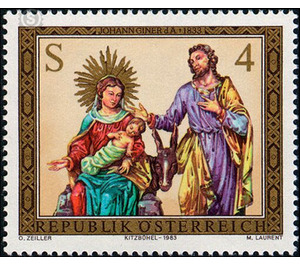Christmas - Austria / II. Republic of Austria 1983 - 4 Shilling
Theme: Calender
| Country | Austria / II. Republic of Austria |
| Issue Date | 1983 |
| Face Value | 4.00 |
| Color | multi-colored brown |
| Printing Type | combination printing |
| Stamp Type | Commemorative |
| Item Type | Stamp |
| Chronological Issue Number | 1102 |
| Chronological Chapter | OOS-OE2 |
| SID | 523414 |
| In 73 Wishlists | |
Kitzbühel has a rich cultural past. The Bavarian Duke Ludwig II gave the settlement in 1271 the city law. In the 15th century copper and silver mining led to great wealth of urban citizens. This economic development also favored the work of painters and sculptors, who in the "Kitzbühel Baroque" radiated heavily into the surrounding countryside. The oldest message about a "Khripl" in Kitzbühel dates back to 1586 and may refer to the St. Andrew's Church. However, this was not a nativity scene in the traditional sense, but a preliminary stage, in which only the Jesus child was placed in a small warehouse in a box. For the St. Andrew's Church a crib appears in 1651 for the first time, for the year 1658 is a new acquisition occupied. Nearly a hundred years later, a crib was bought again. In 1803, this nativity scene was extensively renovated and sold to Tyrol in 1833. The Giner nativity scene of the parish church of St. Andrew was purchased in 1829 before the disposition of the old crib. The magnificent church crib is still in the possession of the parish church and comprises a total of 32 figures. The up to 50 cm high expressive figures in clear Empire version have consistently glass eyes, a technique that is typical for Giner. The brand image shows the birth group of the crib by Johann Giner the Elder. (1756-1833) in the parish church Kitzbühel.


